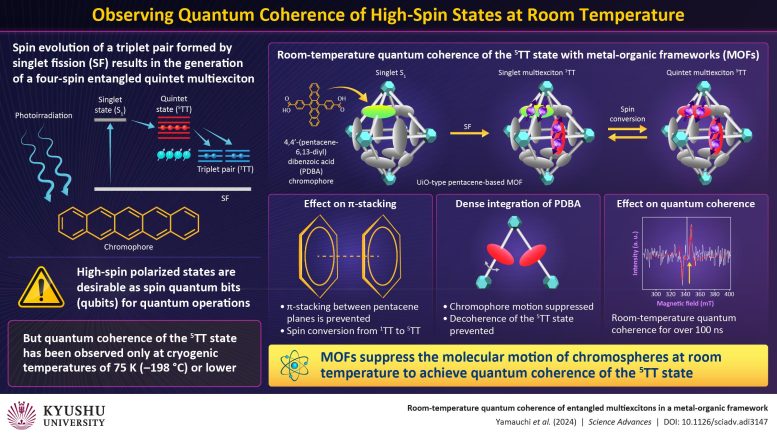
Researchers have achieved quantum coherence at room temperature by embedding a light-absorbing chromophore within a metal-organic framework. This breakthrough, facilitating the maintenance of a quantum system’s state without external interference, marks a significant advancement for quantum computing and sensing technologies.
Researchers observe the quantum coherence of a quintet state with four electron spins in molecular systems for the first time at room temperature.
In a study published in
Advancing Quantum Technologies
Their findings mark a crucial advancement for 
Incorporating a chromophore in a metal-organic framework suppressed the molecular motion sufficiently to maintain the quantum coherence of the quintet state for more than 100 nanoseconds. Credit: Nobuhiro Yanai
Challenges in Quantum Sensing
By leveraging the extremely sensitive nature of a quantum entangled state to environmental noise, quantum sensing technology is expected to enable sensing with higher resolution and sensitivity compared to traditional techniques. However, so far, it has been challenging to entangle four electrons and make them respond to external molecules, that is, achieve quantum sensing using a nanoporous MOF.
Notably, chromophores can be used to excite electrons with desirable electron spins at room temperatures through a process called singlet fission. However, at room temperature causes the quantum information stored in qubits to lose quantum superposition and entanglement. As a result, it is usually only possible to achieve quantum coherence at liquid nitrogen level temperatures.
Innovative Approach to Quantum Coherence
To suppress the molecular motion and achieve room-temperature quantum coherence, the researchers introduced a chromophore based on pentacene (polycyclic aromatic hydrocarbon consisting of five linearly fused benzene rings) in a UiO-type MOF. “The MOF in this work is a unique system that can densely accumulate chromophores. Additionally, the nanopores inside the crystal enable the chromophore to rotate, but at a very restrained angle,” says Yanai.
The MOF structure facilitated enough motion in the pentacene units to allow the electrons to transition from the triplet state to a quintet state, while also sufficiently suppressing motion at room temperature to maintain quantum coherence of the quintet multiexciton state. Upon photoexciting electrons with microwave pulses, the researchers could observe the quantum coherence of the state for over 100 nanoseconds at room temperature. “This is the first room-temperature quantum coherence of entangled quintets,” remarks an excited Kobori.
Future Implications for Quantum Computing
While the coherence was observed only for nanoseconds, the findings will pave the way for designing materials for the generation of multiple qubits at room temperatures. “It will be possible to generate quintet multiexciton state qubits more efficiently in the future by searching for guest molecules that can induce more such suppressed motions and by developing suitable MOF structures,” speculates Yanai. “This can open doors to room-temperature molecular quantum computing based on multiple quantum gate control and quantum sensing of various target compounds.”
Reference: “Room-temperature quantum coherence of entangled multiexcitons in a metal-organic framework” by Akio Yamauchi, Kentaro Tanaka, Masaaki Fuki, Saiya Fujiwara, Nobuo Kimizuka, Tomohiro Ryu, Masaki Saigo, Ken Onda, Ryota Kusumoto, Nami Ueno, Harumi Sato, Yasuhiro Kobori, Kiyoshi Miyata and Nobuhiro Yanai, 3 January 2024, Science Advances.DOI: 10.1126/sciadv.adi3147

